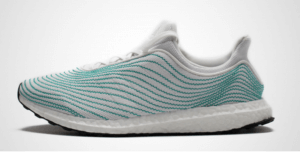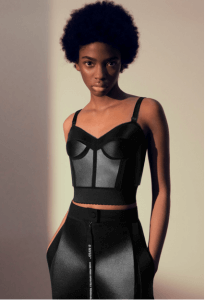The ABC’s of the sustainability trend
From Vegan leather to fair trade shoe production. All the basics you need to know for your next sustainable shoe-purchase.
Since a few years the concept of sustainability can be found anywhere and everywhere.

With brands, such as H&M, Adidas and New Balance, working hard to reinvent their signature, the shoe industry is slowly changing. From shoes and clothing made out of recycled glass and ocean plastic (PET), to local production to reduce the carbon dioxide emission, different brands use a variety of methods and processes to contribute to a more sustainable industry. And lately with great success.
One element is out of the question: The road to sustainability is divers, complex – and most importantly – a long way ahead.
After the collapse of the Rana Plaza, one of the biggest textile factories in Bangladesh, the focal point within the fashion industry changed dramatically. Eight stories filled with machinery and fabrics vanished, along with 1134 employees. Along that line, about 2500 people were (severely) injured. With brands such as H&M and Primark connected to the factory, the overall view of the industry was compromised, to say the least.
It did seem to be a wake-up call, though: Only two years after the Rana Plaza disaster, the United Nations presented their “Sustainable Development Goals”, entailing seventeen sustainable goals. ‘Decent work and Economic Growth’ (goal 8), ‘Responsible consumption and production’ (goal 12) and ‘Climate action’ (goal 13) were included, plus an impressive 169 targets to reach before the year 2030.
With less than ten years to go before the seventeen goals and 169 targets are due, we are looking back to some of the ongoing developments within the sustainability trend, moving from streetwear brands, such as Adidas and New Balance, to small start-ups, like Komrads and Saye. This series on sustainability will enhance all different aspects of the new era: from vegan leather to fair trade and everything in between.
For the upcoming months, OPUS will publish a monthly item focusing on one of the most used terms within the sustainability trend, namely eco-friendly, ethical fashion, circular fashion and – of course – sustainability itself. Every article will give a brief overview of the meaning of the term and will provide you, our reader, with some great tips on what to look out for and what brands to follow. This month’s essay gives an outline on all the above-mentioned terms, just to give a quick indication of what to expect.
Sustainability: cow leather or vegan leather?
Logically, we are starting at the very beginning. The concept of sustainability is often used as an overarching term entailing all concepts mentioned above. This means that anything ranging from ‘vegan’ to ‘naturally biodegradable’ or ‘not made by children’ is considered sustainable. And yes, in a sense, this is true. Though, none of these terms are actually saying anything about the sustainability of the shoe, namely the usage time.
Probably the most sustainable way to purchase shoes is to do some research on the quality of the pair: what is the shoe made of? Can the material withstand different types of weather? And, how many different types of material are used for this shoe? These are all questions that can influence your purchase. Sustainability in that sense, is all about spending money on a good-quality pair of shoes instead of buying ten pairs a year which you know have little usage time.
Eco-friendly: Shoes for dinner (made from fruit and fungi)
Second up is eco-friendly fashion. Compared to sustainability, this concept is more concerned with the well-being of the earth’s flora and fauna and takes this in consideration while producing a new pair of kicks. Some of the eco-friendliest trends that have been going around are the use of alternatives to leather, to minimize animal harm in the shoemaking process.
Vegan leather is gaining popularity among shoe brands, with brands such as Saye and NAE, building entire businesses around this material. This ‘leather’ is made from a variety of products such as fruits. Important to keep in mind, though, is the fact that vegan leather may improve the level of eco-friendliness but does not logically mean that it is sustainable in the sense that it will stay with you through many seasons.
Other eco-friendly processes are based on minimizing the carbon dioxide emission, re-using plastic or reducing water use through more efficient use of machinery, recycling or less transport. Adidas is on the forefront of this trend and recently introduced a new sneaker, the Ultraboost DNA Uncaged, made from ocean plastic (PET).

At the same time, just creating fewer residual materials in the process of shoemaking already contributes to an eco-friendlier industry. In this light, an exciting new material is being tested, namely mycelium. Mylo is the vegetative part of a fungus and serves as an alternative to synthetic materials. A great quality of Mylo is that it grows inside a mould, meaning you can shape the material without creating residual materials. Apart from that, it is strong and 100% natural. So far, Stella McCartney and Lululemon have been experimenting with this fungi leather.
Ethical fashion: fair trade shoes
Yet another stream within the sustainability trend is more concerned with goal 8 of the UN’s SDGs: ‘Decent work and Economic Growth’. Over the years, new brands and organisations were founded with an employee-friendlier goal, such as the well-known Clean Clothes Campaign. The organisation has a rich network, which they use to spread the word on a better working environment and fair loans for employees, something that missed in the Rana Plaza disaster.
Within the shoe industry, this stream of brands, organisations and designers vouches for fair-trade design and humane working environments in factories. The Paris-based brand Sézane, mostly known for their women’s shoes, has been working along the lines of this trend. It promotes fair and safe working conditions for employees and supports philanthropic causes.
And although shoes are often not labelled ‘fair trade’ when displayed in shops or on websites, it is worthwhile to know where a pair of shoes is made and by whose hands those shoes were manufactured. In the end, we experience a better feeling when purchasing shoes made under better conditions.
Circular fashion: composting your shoes
Lastly, a concept that has great resemblance to eco-friendliness, but probably is even more difficult to execute properly: circular fashion. Where eco processes are solemnly focused on the well-being of the flora and fauna, circularity goes beyond their well-being and is constantly looking for ways to create materials that have as little harm as possible on mother earth. Biodegradable materials – materials that decay within weeks, months or years after being out-used without leaving behind residual chemicals – are on the forefront of this trend.
Think of shoes made of fruit peeling (as mentioned earlier on). The peeling is fermented, giving the material a leather-like feel to it. Komrads – a Belgium-based brand – is fully committed to using apple peels as a basis for their new sneaker line. Though other fruits, such as mango or pineapple (Piñatex), are popular types of vegan leather nowadays too. Mylo, the fungi leather, is another great example of a vegan, circular leather type that can be used to create beautiful pairs of shoes.
Another great development is the 3D-printing of shoes. Not only does this exclude residual materials and minimizes the carbon dioxide emission, but shoes are now also printed on the basis of starch instead of plastic, making the shoe 100% ecological.
So, what’s next?
It is safe to state that there are many developments going on within the sustainability trend.
And there are more developments and breakthroughs happening every day. This article lists the most-used terms within the overarching concept of sustainability. And while all these terms are equally important to improve the overall appearance of the shoe industry, the most difficult part has yet to come.
Whether challenging or not, a variety of shoe brands have proven that it is definitely possible to create a pair of kicks that is considered more sustainable in one way or another. None of these brands, though, has been able to tick all the boxes: from sustainability to ethical awareness.
Think about Adidas, and their newly introduced sneakers. These shoes are made of ocean plastic, and therefore considered eco-friendly. The shoe factories of Adidas are still located in countries, where employees are paid little compared to what the shoe actually yields. And at the same time, plastic is far from biodegradable and will probably exist forever. Similarly, Sézane is both ethically responsible and eco-friendly, using recycled packaging and natural materials. But what is the usage time of a pair of their shoes? And are the shoes biodegradable?
The shoe industry has reached an important landmark with the sustainability trend but only now is faced with the important task to continue the developments and improve the processes within the industry. No matter which direction is followed – sustainability, eco-friendly, circular of ethical – the most important thing is that brands are trying to make the shoe industry a better place.
Curious for more? Make sure to check in next month for our first in-depth article on sustainability!The ABC’s
RELATIVE ARTICLES


